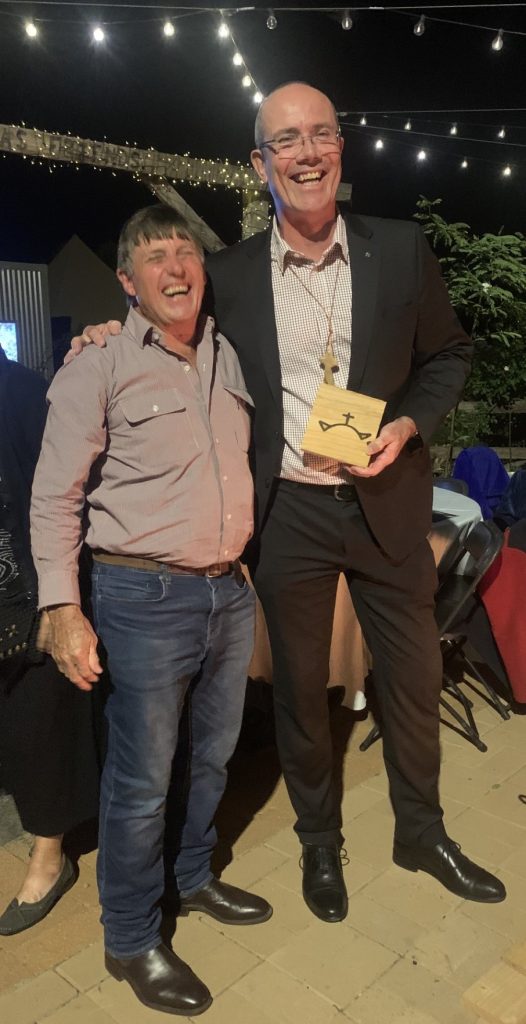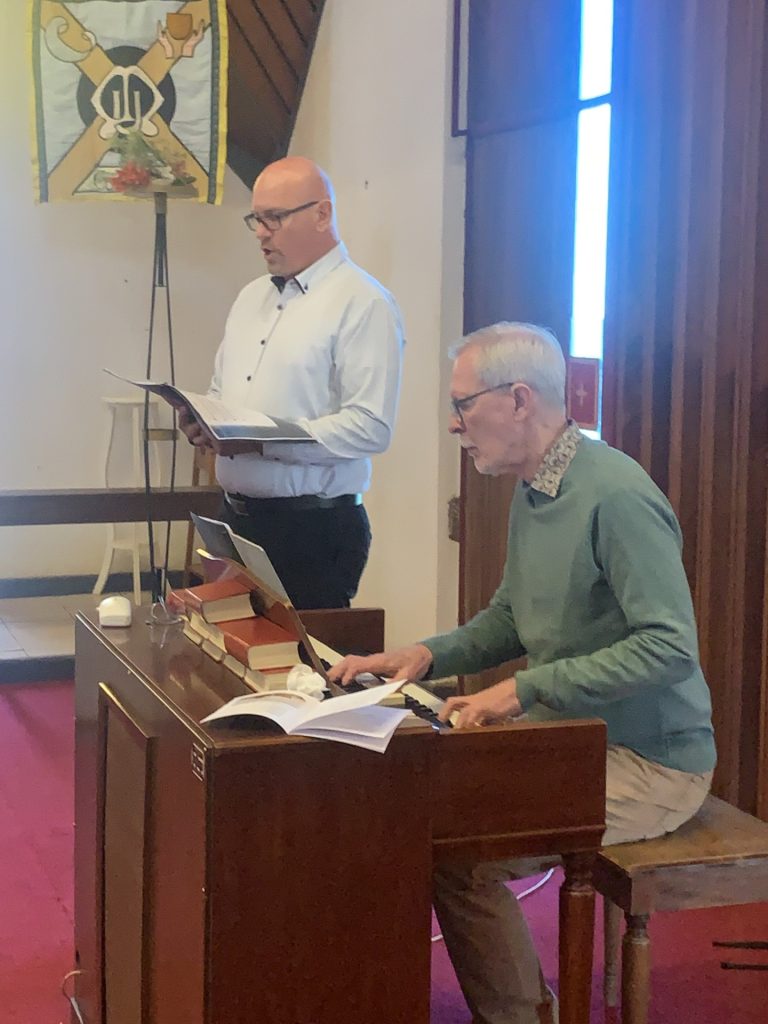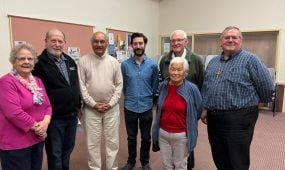A diamond in the dust: St Alban’s, Cunnamulla celebrates 60th anniversary
Local
Sixtieth birthday celebrations for St Alban’s, Cunnamulla drew community members from across the state and beyond for an important milestone in the life of the church, with a weekend of festivities and reminiscences

St Alban’s Anglican Church in Cunnamulla recently celebrated its 60th anniversary with a weekend of celebrations gathering community members from across Queensland, as well as interstate, who shared special connections and fond memories of the parish.

(L-R) The Rev’d Loretta Tyler-Moss, The Rev’d Robert Paget, The Rev’d Helen Paget, The Rev’d David Snape and Bishop Cam Venables at St Alban’s, Cunnamulla in May 2023
Located over 750km west of Brisbane, St Alban’s organised a weekend of events to mark the celebrations, including a barbecue, a town tour, a visit to Cunnamulla’s Railway Station Museum, a gala dinner and a Sunday service with Bishop Cam Venables presiding.
The church hall was decorated with a vast range of memorabilia, including photographs, newspaper cuttings and banners, allowing visitors to reminisce and learn about the church’s origins, its connections to the town and its relationship with the Bush Brothers.
St Alban’s connections to the Bush Brothers
As far back as 1859, it was deemed important to send clergy in pairs to the country areas of Queensland. The availability of sufficient clergy and resources was always a challenge.
lt was not, however, until the arrival of Bishop William Webber in 1885 that the concept of a company of mission priests was devised. The problems of reaching such a vast, remote and scattered population by the Church remained despite the engagement of Archdeacon George Halford with a roving commission.
Advertisement
Halford tried to fill his role from his base in Longreach, but the problems of distance and sufficient clergy remained. Archdeacon Arthur Rivers was appointed to assist, but he had the oversight of an area stretching from Gayndah to Cunnamulla.
In 1901, a newly arrived priest from England, The Rev’d Herbert Puxley, was appointed to assist Rivers in establishing a Bush Brotherhood in Gayndah.
Eventually, Puxley was sent to Charleville from Gayndah to re-establish the Brotherhood in Charleville. The number of brothers was expanded soon after and there were six churches in the Brotherhood area. All Saints’, Charleville; All Saints’, Mitchell; Christ Church, St George; St John’s, Surat; All Souls’, Morven; and, St Alban’s, Cunnamulla. The area covered by the Bush Brotherhood of St Paul was larger than the total area of the British lsles.
As well as endeavouring to meet the spiritual needs of their communities, including Cunnamulla, the Bush Brothers also contributed to the social and cultural life of people in these remote areas through initiatives such as fetes, balls, bazaars and picnics. In this they were ably assisted by other groups, such as the parish Ladies Guild and the Country Women’s Association.
A new church is born
The Church of St Alban the Martyr was dedicated on 2 May 1960 by Bishop John Hudson, Co-adjutor Bishop of the Diocese of Brisbane and Head of the Bush Brotherhood of St Paul.
Confident in Cunnamulla’s future, later that year, Brother Barry Hunter and the parishioners replaced the original church of 1896.
In 1961, the church’s foundation stone was laid and fundraising for the church’s completion began with annual fetes, flower shows, cake stalls, luncheons and raffles, all of which became regular events in Cunnamulla’s social calendar.
By 1963, the church’s construction was completed at a cost of £30,000, and while some of the furniture and ornaments from the original 1896 church were transferred to the new building, generous donations from the town allowed for a new altar, pulpit, lectern, screens, stalls, organ and episcopal chair.
Celebrating 60 years fondly
With friends from Esk, Toowoomba, Tamborine Mountain, Buderim, Hervey Bay, Brisbane, Logan, Charleville, Dubbo and Sydney gathering at the 5 – 7 May anniversary event, memories of Cunnamulla and St Alban’s came rushing back over the weekend, emphasising just how special the church has been to all those who have encountered it.

Peter Thompson and Bishop Cam Venables at St Alban’s anniversary celebrations in May 2023
Peter Thompson, son of the church’s builder, John Thompson, gave a fascinating talk about his father’s challenges in constructing the church, including accessing gravel from the river for the concreting, and putting together the unusual panels needed for the exceptional award-winning architecture — in 2017, Lund, Hutton, Newell, Black & Paulsen Architects received the Robin Gibson Award for Enduring Architecture for St Alban’s Bush Brotherhood Church.
Former schoolteacher Owen Riley shared about playing Jesus in the church’s production of The Passion Play, depicting the events leading to Jesus’ resurrection, in 1972. Over the weekend, he caught up with Chris Mackie who played Mary Magdalene in the production — it the first time they had seen each other since their 1972 performances.

Paul Harper-Green (singing) and Owen Riley playing the organ during anniversary celebrations at St Alban’s in May 2023
Paroo Shire Council Mayor Suzette Beresford also joined in the festivities, speaking warmly of St Alban’s contribution to the wider Cunnamulla community.
The anniversary events were organised by parishioner Carmel Jensen and Lay Minister Merry Higgins who were reminded during festivities of just how many people have been part of the St Alban’s story: “We give thanks for them all – the clergy, parishioners, the wider Anglican community and the community of Cunnamulla,” they said.
While today St Alban’s Anglican Church attracts a smaller flock for its services, the weekend of celebrations was a firm testament to the vibrant community of many around the country that have been touched by this church over the decades and the important part it has played in the lives of many Cunnamulla residents and the wider Anglican community.






